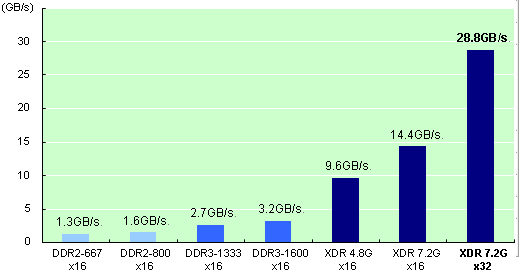malware
New Member
- Joined
- Nov 7, 2004
- Messages
- 5,422 (0.72/day)
- Location
- Bulgaria
| Processor | Intel Core 2 Quad Q6600 G0 VID: 1.2125 |
|---|---|
| Motherboard | GIGABYTE GA-P35-DS3P rev.2.0 |
| Cooling | Thermalright Ultra-120 eXtreme + Noctua NF-S12 Fan |
| Memory | 4x1 GB PQI DDR2 PC2-6400 |
| Video Card(s) | Colorful iGame Radeon HD 4890 1 GB GDDR5 |
| Storage | 2x 500 GB Seagate Barracuda 7200.11 32 MB RAID0 |
| Display(s) | BenQ G2400W 24-inch WideScreen LCD |
| Case | Cooler Master COSMOS RC-1000 (sold), Cooler Master HAF-932 (delivered) |
| Audio Device(s) | Creative X-Fi XtremeMusic + Logitech Z-5500 Digital THX |
| Power Supply | Chieftec CFT-1000G-DF 1kW |
| Software | Laptop: Lenovo 3000 N200 C2DT2310/3GB/120GB/GF7300/15.4"/Razer |
Elpida Memory (Elpida), Japan's leading global supplier of Dynamic Random Access Memory (DRAM), today introduced the industry's first 1-Gigabit XDR DRAM based on a x32-bit configuration. The new XDR product features the industry's fastest ultra-high speed of 7.2GHz, which is faster than any GDDR5 memory chip, and provides a data transfer rate of 28.8 Gigabytes per second with a single device, making it an ideal choice for such high-bandwidth, high-performance full HD-capable applications as game consoles, digital televisions and Blu-ray disc recorders.
"Today's consumer electronics require both high performance and superior power efficiency," said Sharon Holt, senior vice president, Licensing and Marketing at Rambus. "Elpida's leadership with the award-winning XDR memory architecture makes possible a range of great products for consumers to enjoy."
The XDR device is manufactured using Elpida's 65nm process technology and utilizes a 1.5V low voltage operation and an x32-bit interface. It provides a one-chip solution that, compared with two x16-bit configuration 512 Megabit XDR DRAMs, consumes 35-40% less power and requires less space.
"In today's era of digital convergence many existing digital consumer electronic appliances are connecting to the Internet and the use of high compression codecs like H.264/AVC is spreading. This means there is now even more demand for greater bandwidth and higher density memory," said Yoshitaka Kinoshita, Elpida Memory's executive officer in charge of the Mobile & Digital Consumer Division. "Our newly developed 1-Gigabit XDR provides incredibly high bandwidth with lower operating power to meet the systems needs of our customers. Elpida will continue to focus on reducing the power consumption of XDR DRAMs, which we believe can also lead to tremendous application potential in portable devices."
Sample shipments of the new XDR have already started and mass production is scheduled to begin in April 2009.
As a top supplier of XDR DRAM, Elpida continues to specialize in developing high-performance, low-power XDR products.
New Product Features

DRAM Bandwidth

View at TechPowerUp Main Site
"Today's consumer electronics require both high performance and superior power efficiency," said Sharon Holt, senior vice president, Licensing and Marketing at Rambus. "Elpida's leadership with the award-winning XDR memory architecture makes possible a range of great products for consumers to enjoy."
The XDR device is manufactured using Elpida's 65nm process technology and utilizes a 1.5V low voltage operation and an x32-bit interface. It provides a one-chip solution that, compared with two x16-bit configuration 512 Megabit XDR DRAMs, consumes 35-40% less power and requires less space.
"In today's era of digital convergence many existing digital consumer electronic appliances are connecting to the Internet and the use of high compression codecs like H.264/AVC is spreading. This means there is now even more demand for greater bandwidth and higher density memory," said Yoshitaka Kinoshita, Elpida Memory's executive officer in charge of the Mobile & Digital Consumer Division. "Our newly developed 1-Gigabit XDR provides incredibly high bandwidth with lower operating power to meet the systems needs of our customers. Elpida will continue to focus on reducing the power consumption of XDR DRAMs, which we believe can also lead to tremendous application potential in portable devices."
Sample shipments of the new XDR have already started and mass production is scheduled to begin in April 2009.
As a top supplier of XDR DRAM, Elpida continues to specialize in developing high-performance, low-power XDR products.
New Product Features

DRAM Bandwidth

View at TechPowerUp Main Site




